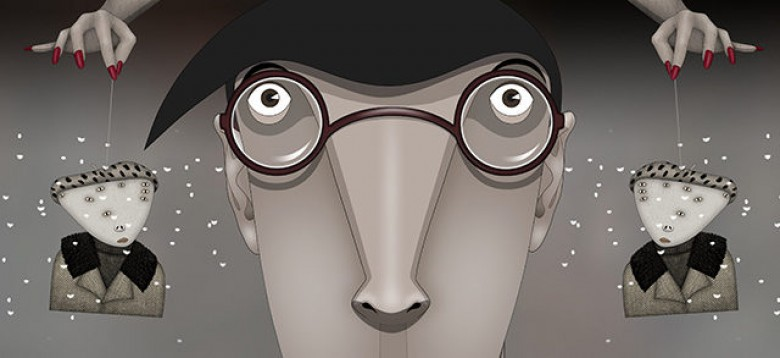“Characters from famous paintings continue to attack me”
Writer/director Milorad Krstic has combined his love for painting and film into an action thriller as surreal as it is familiar. The whole uses his own unique animation style as a filter with which to recreate masterpieces of both visual mediums—each famed piece simultaneously recognizable as its real life counterpart and integrated into the over-arching aesthetic onscreen. Think Modigliani (with his elongated faces and pasted on noses) by way of Picasso (with a Cubist sensibility fracturing norms to include three eyes or three faces). Easter eggs litter the frame with Dada advertisements in the background to offset collections of straight razors from the annals of cinema. You will try and fail to see everything on first glance, but that’s what Blu-rays and the pause button are for.
The plot he and cowriter Radmila Roczkov concocted for Ruben Brandt, Collector concerns an art therapist (Iván Kamarás‘ Ruben Brandt) suddenly in need of his own psychological assistance one-month removed from the passing of his father. He’s haunted by paintings from Botticelli’s Venusto Andy Warhol’s Double Elvis, each coming to life in his dreams to place him in some sort of peril before awakening with violent, self-inflicted remnants of the abuses experienced. Unsure of why it’s happening, the only thing he remembers doing differently since the funeral was watching the old reel-to-reel cartoons in his Dad’s laboratory. You wouldn’t think something so innocuous could trigger such torture, but two shadowy figures (Paul Bellantoni‘s John Cooper and Iván Hegedűs’ Bruno) explain over drinks how it could.
For this we go back in time to learn about Gerhard Brandt’s covert work in subliminal messaging for the CIA. Who knows what was spliced into those cartoons or what experimentations he performed on his son as a boy? Somehow Ruben’s love of art as a form of healing has now warped into a specter of destruction and it’s starting to affect his ability to treat those in his care. That these patients are criminals (Matt Devere‘s Bye-Bye Joe, Christian Nielson Buckholdt‘s Fernando, and Henry Grant‘s Membrano Bruno) becomes inconsequential because even thieves need help combatting what ails them. So when a new cat burglar (Gabriella Hámori‘s Mimi) joins their ranks and discovers Ruben is hurting too, they combine their unsavory skills with his therapy tactics to cure him.
They know from their own experiences that Ruben must utilize ownership tactics. He must possess what scares him in order to overcome his fear through empowerment. So if Édouard Manet’s Olympia is haunting him, he has to claim the canvas that holds her as his own. Each dream therefore targets the next heist until Ruben becomes a part of the crew. It’s working after all, so why would he stop things if they’ve been able to get away with it thus far? The police assume it can’t be someone they know considering the works being stolen are too famous to ever sell, so everyone is running around devoid of direction—everyone but private detective Mike Kowalski (Csaba Márton). He’s been hired for his own expertise as a “collector.”
His employers are the gallery insurers losing their minds. And behind him are gangsters piggybacking their way into the investigation to steal the artwork from Ruben before Kowalski can make an arrest. Add a previous cat and mouse chase between the detective and Mimi, familial secrets that could tie unlikely characters together, and a couple lounge covers with Radiohead’s “Creep” and Britney Spears’ “Oops! … I Did It Again” and you’re only scratching the surface of how dense Krstic’s puzzle box of homage and artistry proves. For this reason I look at the shelled gastropod popping up throughout as a representation of Henri Matisse’s paper cutouts (gouaches découpées) The Snail. Krstic is tearing art from its historical context and pasting it together to form a brand new world.
It’s a wild enterprise with enough thrills to hold the attention of audiences that couldn’t care less about art or cinematic history, but it only truly works for those who have art and cinematic history coursing through their veins. They’re the ones who smile when Ruben stumbles into Edward Hopper’s Nighthawks to face a bandaged assailant or when an ice sculpted Alfred Hitchcock bobs up and down in Kowalski’s whiskey glass. I say this because the plot can be very convoluted with a ton of threads that ultimately go nowhere and thus rely on the visual distractions to stop us from peering too deep. So don’t expect that answers to why Gerhard brainwashed his son or who Kowalski’s father is will go anywhere. It’s all noise.
The same goes with Mimi’s exploits despite being positioned as more second lead than Kowalski. What these characters do or why they do it becomes meaningless once we acknowledge that Krstic’s main motivation is to quell their minds’ troubles. What happens to the stolen paintings or where everyone goes after the thirteenth and final canvas is liberated from its gilded prison is for our imagination to infer. Krstic is only interested in whether or not he can end his film with Ruben and the other anti-hero protagonists finding themselves cured of the impulses that were preventing them from excelling at their jobs (again, illegal jobs of crime for most). If they exit this nightmarish adventure with clear heads, their futures become wide open. Art can free them all.
Score: 7/10
Rating: R | Runtime: 96 minutes | Release Date: June 22nd, 2018 (Hungary)
Studio: Mozinet / Sony Pictures Classics
Director(s): Milorad Krstic
Writer(s): Milorad Krstic & Radmila Roczkov

